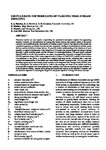Coupled RANS-VOF modelling of floating tidal stream concepts
| dc.contributor.author | Ransley, E | |
| dc.contributor.author | Brown, Scott Andrew | |
| dc.contributor.author | Greaves, Deborah | |
| dc.contributor.author | Hindley, S | |
| dc.contributor.author | Weston, P | |
| dc.contributor.author | Guerrini, E | |
| dc.date.accessioned | 2019-04-04T09:39:59Z | |
| dc.date.available | 2019-04-04T09:39:59Z | |
| dc.date.issued | 2016-09-12 | |
| dc.identifier.uri | http://hdl.handle.net/10026.1/13619 | |
| dc.description.abstract |
Numerical models are now capable of providing the quantitative description required for engineering analysis. However, for structures such as floating tidal stream devices, the complex nature of the system can rarely be included using the functionality of existing models. Typically key aspects of the system are considered separately or omitted from the analysis completely, leading to uncertainties in both the power delivery and survivability of these devices. To provide a better understanding of the behaviour of such systems, a coupled Computational Fluid Dynamics (CFD) model has been developed including a floating structure, 4-point mooring system and the influence of a submerged turbine. The open-source software OpenFOAM® solves the fully nonlinear, two-phase, incompressible, Reynolds-Averaged Navier-Stokes (RANS) equations using a finite volume approach and a Volume of Fluid (VOF) method for the interface. The behaviour of the device is included via a coupled rigid-body solver, combined with a two-way actuator line representation of the turbine and a new hybrid-catenary mooring model. Full scale test cases including regular waves and currents, based on those at the Perpetuus Tidal Energy Centre (PTEC), have been investigated. The motion of the device, loads in the moorings and thrust on the turbine have been calculated and compared with those predicted by a potential flow code and mooring analysis software. It is shown that the turbine, currents and moorings have significant impacts on the structure’s response, and are therefore important in assessing the fatigue life and power capture of floating tidal stream concepts. | |
| dc.language.iso | en | |
| dc.title | Coupled RANS-VOF modelling of floating tidal stream concepts | |
| dc.type | conference | |
| plymouth.date-start | 2016-09-12 | |
| plymouth.date-finish | 2016-09-14 | |
| plymouth.conference-name | in Proceedings of the 2nd International Conference on Offshore Renewable Energy (CORE) | |
| plymouth.organisational-group | /Plymouth | |
| plymouth.organisational-group | /Plymouth/Faculty of Science and Engineering | |
| plymouth.organisational-group | /Plymouth/Faculty of Science and Engineering/School of Engineering, Computing and Mathematics | |
| plymouth.organisational-group | /Plymouth/PRIMaRE Publications | |
| plymouth.organisational-group | /Plymouth/REF 2021 Researchers by UoA | |
| plymouth.organisational-group | /Plymouth/REF 2021 Researchers by UoA/UoA12 Engineering | |
| plymouth.organisational-group | /Plymouth/Research Groups | |
| plymouth.organisational-group | /Plymouth/Research Groups/Marine Institute | |
| plymouth.organisational-group | /Plymouth/Users by role | |
| plymouth.organisational-group | /Plymouth/Users by role/Academics | |
| plymouth.organisational-group | /Plymouth/Users by role/Researchers in ResearchFish submission | |
| dc.publisher.place | Glasgow, Scotland | |
| dcterms.dateAccepted | 2016-09-12 | |
| dc.rights.embargoperiod | Not known | |
| rioxxterms.licenseref.uri | http://www.rioxx.net/licenses/all-rights-reserved | |
| rioxxterms.licenseref.startdate | 2016-09-12 | |
| rioxxterms.type | Conference Paper/Proceeding/Abstract |


